|
|
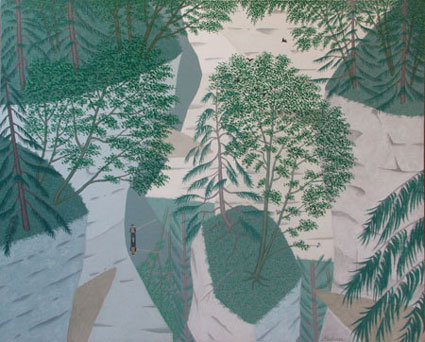 LANDSCAPE AS METAPHOR LANDSCAPE AS METAPHOR
"It is in vain to dream of a wilderness distant from ourselves.
There is none such. It is the
bog in our brains and bowels,
the primitive vigor of Nature in us, that inspires that dream".
Henry David Thoreau Journal, August 30, 1856
One of the founding fathers of modern environmentalism, Thoreau touched on sentiments which contemporary society still struggles with today, man's relationship with nature; our search to find ways in which to interact with the natural world.
Over the course of history artists have worked at communicating the richness and complexity of the landscape tradition. Painters such as van Gogh, Matisse and Cezanne among others tried in their paintings to give form to a different possibility of man within nature, in a dynamic and reciprocal relationship. It was Cezanne, more than any other who sought to paint nature from within. He referred to himself as the "primitive of his age". Few artists who came after pursued the same intent, the search for a vision, a visual metaphor for a life affirming future, in which mankind lives in harmony with nature.
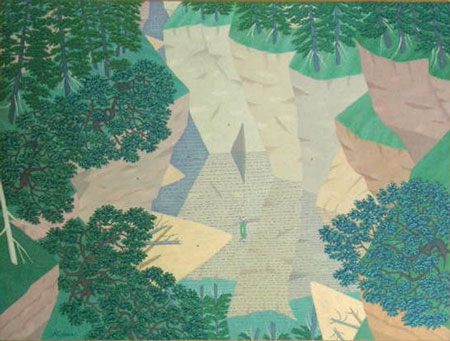 The Gorgeous Gorges series by Robert Michener portrays serpentine rivers and deep canyon pools embraced by cliffs, scaling rock formations and wild foliage. These oil on linen and canvas works mark a new direction for this Surrey-based artist. Following his farm paintings of the 1980s and early 90s these works are born out of his struggle to find a new motif in which to release his creative energies. Consistent with his long-standing values and expressive intentions, Michener returned to his past, to experiences from his childhood growing up in a rural community in the southeastern corner of Minnesota, an area that is geographically unique to that region. This revisitation to his youth sparked memories of that area. Remembrances of roaming around in the wilderness - hiking, fishing, hunting and bird watching, memories of those hills, valleys, streams and cliffs form the basis for this series. The Gorgeous Gorges series by Robert Michener portrays serpentine rivers and deep canyon pools embraced by cliffs, scaling rock formations and wild foliage. These oil on linen and canvas works mark a new direction for this Surrey-based artist. Following his farm paintings of the 1980s and early 90s these works are born out of his struggle to find a new motif in which to release his creative energies. Consistent with his long-standing values and expressive intentions, Michener returned to his past, to experiences from his childhood growing up in a rural community in the southeastern corner of Minnesota, an area that is geographically unique to that region. This revisitation to his youth sparked memories of that area. Remembrances of roaming around in the wilderness - hiking, fishing, hunting and bird watching, memories of those hills, valleys, streams and cliffs form the basis for this series.
The interplay between wild nature and nature shaped by man has been a dominant metaphor in his art for the past thirty years. Michener's roots are in Abstract Expressionism, a movement which developed out of New York in the 1940s and 50s. Rather than seeing paintings as representations of the world outside the artwork, Abstract Expressionists looked at painting in terms of essential elements of form such as line, colour, texture, light and dark and scale. These elements were a basic vocabulary used to express ideas, emotions, and spirituality. Form and content were acknowledged as joined and interdependent. Jackson Pollack and William de Kooning's emphasis on spontaneity influenced Michener's work.
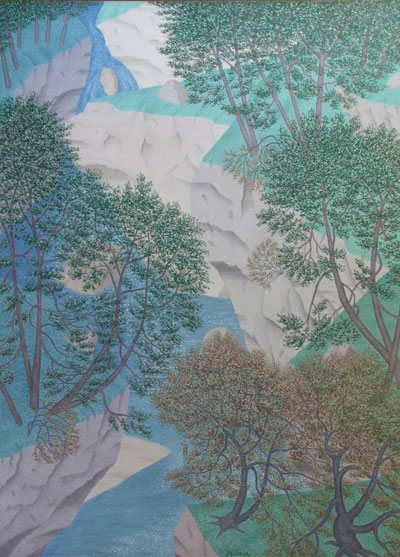 Over the last three decades, he has evolved from an initially non-representational action painter, then moved into realism with the figure in the landscape as the dominant motif. Over the years, both the figure and landscape have shifted in their prominence and stylistic rendering. In his beach scenes of the 1960s, the figure was dominant, although often set against a foil of wild nature. The Howe Sound paintings of the 1970s saw the human presence become diminutive against the grandeur of the mountain scapes. In the mid 70s with his beach, park and city scenes the balance tipped the other way. By the late 70s with his series of paintings of the Badlands of South Dakota the wilderness again prevailed. The 80s and early 90s again saw a shift in his work with his farm paintings. Domesticated nature was central, although generally set within or intertwined with wilderness. With this current series of work, Michener has again turned to the wilderness. Yet, this work is not typical of the previous vistas of mountains or the Badlands. He has chosen to reflect a more intimate experience using images of the cliffs and streams of his youth. Informed and influenced by traditional Chinese landscape paintings theme of spirit and nature, Michener believes "the presence of the fishermen symbolize an intimate human bond with nature. Over the last three decades, he has evolved from an initially non-representational action painter, then moved into realism with the figure in the landscape as the dominant motif. Over the years, both the figure and landscape have shifted in their prominence and stylistic rendering. In his beach scenes of the 1960s, the figure was dominant, although often set against a foil of wild nature. The Howe Sound paintings of the 1970s saw the human presence become diminutive against the grandeur of the mountain scapes. In the mid 70s with his beach, park and city scenes the balance tipped the other way. By the late 70s with his series of paintings of the Badlands of South Dakota the wilderness again prevailed. The 80s and early 90s again saw a shift in his work with his farm paintings. Domesticated nature was central, although generally set within or intertwined with wilderness. With this current series of work, Michener has again turned to the wilderness. Yet, this work is not typical of the previous vistas of mountains or the Badlands. He has chosen to reflect a more intimate experience using images of the cliffs and streams of his youth. Informed and influenced by traditional Chinese landscape paintings theme of spirit and nature, Michener believes "the presence of the fishermen symbolize an intimate human bond with nature.
" Fly-Fishing 1995-96, the first work in this series, Michener schematizes rock forms and makes the water into parallel ripples, so that each becomes a specific linear area of rhythmic pattern. By focusing not on specific details but more on the use of colour, shape and line, Michener has created his own individual idiom. He employs a subtle control of light and shade to create the clear, crisp brightness present in nature, as well as having the full range of blues and greens to accompany it. The work itself takes on an eternal verity; the picture of an earthly paradise. The composition of this work shows the wild, rugged majesty of landscape.
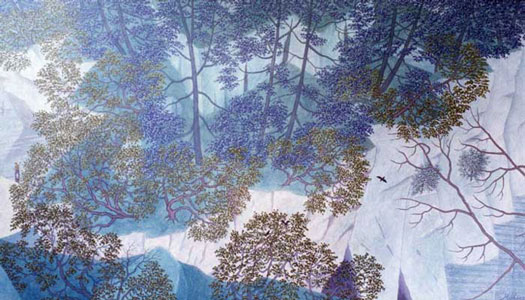 Michener's landscapes take on a lyrical and almost decorative quality. His paintings are characterized by careful finishing, subtle use of colour, pattern, design and spatial clarify. His masterful colour sense and ability to simplify forms have created a recognizable and distinctive style. The calm, flattened images balanced with soft tones and an almost grid-like pattern of imagery are strategies utilized consistently by Michener in this collection of work. Michener's landscapes take on a lyrical and almost decorative quality. His paintings are characterized by careful finishing, subtle use of colour, pattern, design and spatial clarify. His masterful colour sense and ability to simplify forms have created a recognizable and distinctive style. The calm, flattened images balanced with soft tones and an almost grid-like pattern of imagery are strategies utilized consistently by Michener in this collection of work.
In Fishing at First Light, 1997 dominant trees are bursting forth out of the confines which are holding it in illustrating the immense unruliness of nature. This work delights in rich foliage and the wild rush of great canyon falls into deep calm pools. Using this imagery as his main source of subject matter, he is showing the viewer a unique perspective of viewing nature and the wilderness. His work illustrates the sublime aspects of nature. The tall, thick, dense trees and scaling cliffs emphasize the majestic qualifies of nature and how they dwarf the figures within their midst.
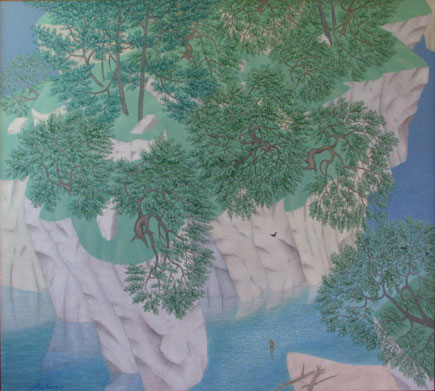 These invented landscapes communicate the total and solid presence of nature. Design elements hold the work together. Never a realist, Michener has endeavored to impose an order of logic and playful formalism into his images. Each painting in this series illustrates a different vista that suggest a sense of continuity in his work. He feels that spatial illusion is a major expressive means available to painters. The sense of scale being achieved through the illusion of space and the tension between the actual and the illusion. Employing a technique of traditional Chinese landscape painting, he creates the illusion of distance by decreasing the clarity as well as by decreasing size. The aesthetic appeal of the images resides in the relationship between the mood evoked by color and formal elements. The results of this technique can be seen in renderings of the trees and cliffs in Spring, Wind, Cliffs and Crows, 1997. His use of aerial views, distorted perspective and close-up elements such as rocks and foliage interrupt the spatial clarity of his scenes. The viewer is never regulated to one point of view through typical techniques of perspectives but rather is shown all of the scene. Viewing the work, one never knows quite where they stand within the landscape. These invented landscapes communicate the total and solid presence of nature. Design elements hold the work together. Never a realist, Michener has endeavored to impose an order of logic and playful formalism into his images. Each painting in this series illustrates a different vista that suggest a sense of continuity in his work. He feels that spatial illusion is a major expressive means available to painters. The sense of scale being achieved through the illusion of space and the tension between the actual and the illusion. Employing a technique of traditional Chinese landscape painting, he creates the illusion of distance by decreasing the clarity as well as by decreasing size. The aesthetic appeal of the images resides in the relationship between the mood evoked by color and formal elements. The results of this technique can be seen in renderings of the trees and cliffs in Spring, Wind, Cliffs and Crows, 1997. His use of aerial views, distorted perspective and close-up elements such as rocks and foliage interrupt the spatial clarity of his scenes. The viewer is never regulated to one point of view through typical techniques of perspectives but rather is shown all of the scene. Viewing the work, one never knows quite where they stand within the landscape.
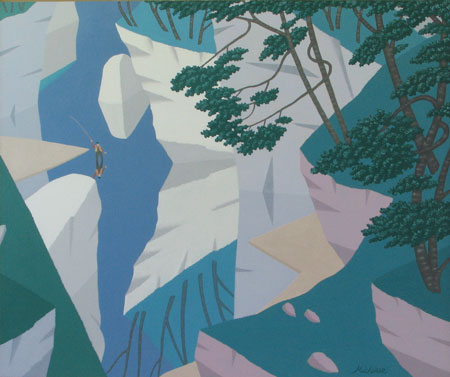 As an artist, Michener endeavours to create a world in which he would like to exist. He affirms aspects of life which he sees as life enhancing and denies those which appear destructive. Although they frequently derive from specific locations or combinations of several sites, the structures of the paintings in this series are imaginative. His work combats feelings of aggressiveness and masculinity which typically occur in contemporary Western art. He is influenced by the gentle, feminine and playfulness found in traditions of Oriental art. Michener feels that these ideals are needed today if we are to learn to relate to nature in a positive way. His work challenges the perception of viewing. He creates an illusion by arranging elements found in landscape, the land, water and sky, trees and rocks in a way which the viewer is led to play within these elements and interact with them on an emotive and intellectual level. The viewer is to be a participant in the process and interact with nature's dance. As an artist, Michener endeavours to create a world in which he would like to exist. He affirms aspects of life which he sees as life enhancing and denies those which appear destructive. Although they frequently derive from specific locations or combinations of several sites, the structures of the paintings in this series are imaginative. His work combats feelings of aggressiveness and masculinity which typically occur in contemporary Western art. He is influenced by the gentle, feminine and playfulness found in traditions of Oriental art. Michener feels that these ideals are needed today if we are to learn to relate to nature in a positive way. His work challenges the perception of viewing. He creates an illusion by arranging elements found in landscape, the land, water and sky, trees and rocks in a way which the viewer is led to play within these elements and interact with them on an emotive and intellectual level. The viewer is to be a participant in the process and interact with nature's dance.
Gorgeous Gorges creates visual symbols that articulate the gentle and reciprocal relationship that is possible between humanity and the rest of nature. Michener sees his work as practical metaphors for a new way of feeling and living with the world, to suggest a reverence for all life, yet not religious. "If my paintings seem to hearken back to a bygone era to a reality not open to most people living in an ever-increasing urban environment and social world, I can only say that it is so. I project an ideal symbol."
Christine Lawrance
|

 LANDSCAPE AS METAPHOR
LANDSCAPE AS METAPHOR The Gorgeous Gorges series by Robert Michener portrays serpentine rivers and deep canyon pools embraced by cliffs, scaling rock formations and wild foliage. These oil on linen and canvas works mark a new direction for this Surrey-based artist. Following his farm paintings of the 1980s and early 90s these works are born out of his struggle to find a new motif in which to release his creative energies. Consistent with his long-standing values and expressive intentions, Michener returned to his past, to experiences from his childhood growing up in a rural community in the southeastern corner of Minnesota, an area that is geographically unique to that region. This revisitation to his youth sparked memories of that area. Remembrances of roaming around in the wilderness - hiking, fishing, hunting and bird watching, memories of those hills, valleys, streams and cliffs form the basis for this series.
The Gorgeous Gorges series by Robert Michener portrays serpentine rivers and deep canyon pools embraced by cliffs, scaling rock formations and wild foliage. These oil on linen and canvas works mark a new direction for this Surrey-based artist. Following his farm paintings of the 1980s and early 90s these works are born out of his struggle to find a new motif in which to release his creative energies. Consistent with his long-standing values and expressive intentions, Michener returned to his past, to experiences from his childhood growing up in a rural community in the southeastern corner of Minnesota, an area that is geographically unique to that region. This revisitation to his youth sparked memories of that area. Remembrances of roaming around in the wilderness - hiking, fishing, hunting and bird watching, memories of those hills, valleys, streams and cliffs form the basis for this series.  Over the last three decades, he has evolved from an initially non-representational action painter, then moved into realism with the figure in the landscape as the dominant motif. Over the years, both the figure and landscape have shifted in their prominence and stylistic rendering. In his beach scenes of the 1960s, the figure was dominant, although often set against a foil of wild nature. The Howe Sound paintings of the 1970s saw the human presence become diminutive against the grandeur of the mountain scapes. In the mid 70s with his beach, park and city scenes the balance tipped the other way. By the late 70s with his series of paintings of the Badlands of South Dakota the wilderness again prevailed. The 80s and early 90s again saw a shift in his work with his farm paintings. Domesticated nature was central, although generally set within or intertwined with wilderness. With this current series of work, Michener has again turned to the wilderness. Yet, this work is not typical of the previous vistas of mountains or the Badlands. He has chosen to reflect a more intimate experience using images of the cliffs and streams of his youth. Informed and influenced by traditional Chinese landscape paintings theme of spirit and nature, Michener believes "the presence of the fishermen symbolize an intimate human bond with nature.
Over the last three decades, he has evolved from an initially non-representational action painter, then moved into realism with the figure in the landscape as the dominant motif. Over the years, both the figure and landscape have shifted in their prominence and stylistic rendering. In his beach scenes of the 1960s, the figure was dominant, although often set against a foil of wild nature. The Howe Sound paintings of the 1970s saw the human presence become diminutive against the grandeur of the mountain scapes. In the mid 70s with his beach, park and city scenes the balance tipped the other way. By the late 70s with his series of paintings of the Badlands of South Dakota the wilderness again prevailed. The 80s and early 90s again saw a shift in his work with his farm paintings. Domesticated nature was central, although generally set within or intertwined with wilderness. With this current series of work, Michener has again turned to the wilderness. Yet, this work is not typical of the previous vistas of mountains or the Badlands. He has chosen to reflect a more intimate experience using images of the cliffs and streams of his youth. Informed and influenced by traditional Chinese landscape paintings theme of spirit and nature, Michener believes "the presence of the fishermen symbolize an intimate human bond with nature.  Michener's landscapes take on a lyrical and almost decorative quality. His paintings are characterized by careful finishing, subtle use of colour, pattern, design and spatial clarify. His masterful colour sense and ability to simplify forms have created a recognizable and distinctive style. The calm, flattened images balanced with soft tones and an almost grid-like pattern of imagery are strategies utilized consistently by Michener in this collection of work.
Michener's landscapes take on a lyrical and almost decorative quality. His paintings are characterized by careful finishing, subtle use of colour, pattern, design and spatial clarify. His masterful colour sense and ability to simplify forms have created a recognizable and distinctive style. The calm, flattened images balanced with soft tones and an almost grid-like pattern of imagery are strategies utilized consistently by Michener in this collection of work. These invented landscapes communicate the total and solid presence of nature. Design elements hold the work together. Never a realist, Michener has endeavored to impose an order of logic and playful formalism into his images. Each painting in this series illustrates a different vista that suggest a sense of continuity in his work. He feels that spatial illusion is a major expressive means available to painters. The sense of scale being achieved through the illusion of space and the tension between the actual and the illusion. Employing a technique of traditional Chinese landscape painting, he creates the illusion of distance by decreasing the clarity as well as by decreasing size. The aesthetic appeal of the images resides in the relationship between the mood evoked by color and formal elements. The results of this technique can be seen in renderings of the trees and cliffs in Spring, Wind, Cliffs and Crows, 1997. His use of aerial views, distorted perspective and close-up elements such as rocks and foliage interrupt the spatial clarity of his scenes. The viewer is never regulated to one point of view through typical techniques of perspectives but rather is shown all of the scene. Viewing the work, one never knows quite where they stand within the landscape.
These invented landscapes communicate the total and solid presence of nature. Design elements hold the work together. Never a realist, Michener has endeavored to impose an order of logic and playful formalism into his images. Each painting in this series illustrates a different vista that suggest a sense of continuity in his work. He feels that spatial illusion is a major expressive means available to painters. The sense of scale being achieved through the illusion of space and the tension between the actual and the illusion. Employing a technique of traditional Chinese landscape painting, he creates the illusion of distance by decreasing the clarity as well as by decreasing size. The aesthetic appeal of the images resides in the relationship between the mood evoked by color and formal elements. The results of this technique can be seen in renderings of the trees and cliffs in Spring, Wind, Cliffs and Crows, 1997. His use of aerial views, distorted perspective and close-up elements such as rocks and foliage interrupt the spatial clarity of his scenes. The viewer is never regulated to one point of view through typical techniques of perspectives but rather is shown all of the scene. Viewing the work, one never knows quite where they stand within the landscape. As an artist, Michener endeavours to create a world in which he would like to exist. He affirms aspects of life which he sees as life enhancing and denies those which appear destructive. Although they frequently derive from specific locations or combinations of several sites, the structures of the paintings in this series are imaginative. His work combats feelings of aggressiveness and masculinity which typically occur in contemporary Western art. He is influenced by the gentle, feminine and playfulness found in traditions of Oriental art. Michener feels that these ideals are needed today if we are to learn to relate to nature in a positive way. His work challenges the perception of viewing. He creates an illusion by arranging elements found in landscape, the land, water and sky, trees and rocks in a way which the viewer is led to play within these elements and interact with them on an emotive and intellectual level. The viewer is to be a participant in the process and interact with nature's dance.
As an artist, Michener endeavours to create a world in which he would like to exist. He affirms aspects of life which he sees as life enhancing and denies those which appear destructive. Although they frequently derive from specific locations or combinations of several sites, the structures of the paintings in this series are imaginative. His work combats feelings of aggressiveness and masculinity which typically occur in contemporary Western art. He is influenced by the gentle, feminine and playfulness found in traditions of Oriental art. Michener feels that these ideals are needed today if we are to learn to relate to nature in a positive way. His work challenges the perception of viewing. He creates an illusion by arranging elements found in landscape, the land, water and sky, trees and rocks in a way which the viewer is led to play within these elements and interact with them on an emotive and intellectual level. The viewer is to be a participant in the process and interact with nature's dance.